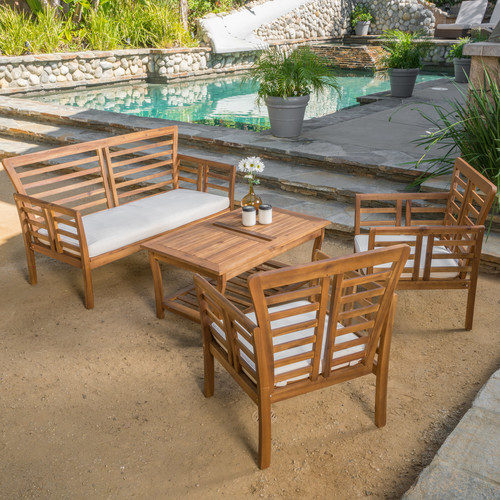Acacia Wood: Exploring the Benefits & Characteristics
In the world of interior design and furniture craftsmanship, there are certain materials that stand out for their timeless beauty, remarkable durability, and versatility. Acacia wood, derived from the acacia tree, is undoubtedly one such material. With its rich history, unique characteristics, and remarkable strength, acacia wood has become a cherished choice for creating stunning furniture, flooring, and decorative accents.
In this blog post, we delve into the captivating world of acacia wood. We’ll explore its origins, delve into its distinct features, and uncover the reasons why it has become a favorite among homeowners and designers alike. Whether you’re considering incorporating acacia wood into your home or simply intrigued by its allure, join me as I unravel the facts of this remarkable material.
A History Rooted in Tradition
Acacia wood has a storied past, deeply rooted in tradition and cultural significance. The acacia tree, native to regions such as Africa, Asia, and Australia, has been revered for centuries for its strength, resilience, and beauty. In ancient times, acacia wood was often used in the construction of temples, sacred structures, and even Egyptian sarcophagi. It’s durability and symbolic importance have made it a treasured material throughout history. The image below is an example of an Egyptian coffin made from acacia wood in approximately 3100 – 2890 BCE.
Acacia trees are found in tropical and subtropical regions around the world. There are over 1,300 species of acacia, and each one has its own unique characteristics. Some of the most popular species for use in woodworking include:
- Acacia melanoxylon (blackwood): This species is native to Australia and has a deep, rich color. It is known for its strength and durability and it is often used for outdoor furniture and flooring.
- Acacia koa (koa): This species is native to Hawaii and has a beautiful, wavy grain. It is prized for its use in high-end furniture and musical instruments.
- Acacia mangium (mangium): This species is native to Southeast Asia and is known for its fast growth rate. It is often used



Why is Acacia Wood Popular?
One of the key reasons for the popularity of this wood lies in its distinctive characteristics. The wood is known for its rich, warm tones ranging from golden browns to deep mahogany hues, creating a sense of natural elegance in any space. The unique grain patterns, swirls, and knots add depth and character to furniture pieces, flooring, and musical instruments. Additionally, acacia wood is used in cutting boards, bowls and serving platters, due to its food-safe properties and natural antibacterial characteristics.
Its dense composition, and high resistance to scratches and dents make it ideal for pieces that endure daily use. Furthermore, the wood’s natural oils make it highly resistant to water damage and insect infestations, ensuring its long-lasting durability. These qualities make the wood suitable for both indoor and outdoor applications.
Acacia wood’s versatility knows no bounds. As mentioned earlier, it can be crafted into a wide range of furniture pieces; from rustic farmhouse tables, bed and bookshelves to sleek contemporary cabinets. Its ability to seamlessly blend into various design styles makes it a sought-after choice for both traditional and modern interiors. In addition to furniture, this wood is suitable for outdoor furniture, decking, and other exterior applications because of its resistance to moisture, decay and pests, allowing you to extend its beauty beyond your home’s interior.
Sustainable and Eco-Friendly
As the world embraces sustainability and environmental consciousness, acacia wood shines as an eco-friendly choice. Acacia trees are known for their rapid growth, making them a renewable resource. Responsible sourcing and proper forest management practices ensure the sustainability of acacia wood production. By choosing this wood, you not only enhance the beauty of your living space but also contribute to the preservation of forests and by reducing the ecological footprint.
Care and Maintenance of Acacia Wood
To ensure the longevity and beauty of acacia wood furniture or flooring, proper care and maintenance is essential. Routine dusting, and cleaning with a soft cloth or a mild, wood-specific cleaner to remove dirt and debris will help preserve its natural luster. If you use a cleaning product, avoid using anything containing silicone or ammonia as it will dry out the wood and wear down the finish much faster.
Periodic applications of wood oil or wax can restore the wood’s protective finish, ensuring its longevity and enhancing its inherent beauty. Additionally, it’s important If you want more information on wood finishes and, and the differences between them, you’ll want to check out my article! You may also want more information on which finishes are food safe.
Summary
Acacia wood stands as remarkable material, admired for its unique characteristics, durability, and versatility. It’s striking grain pattern, warm tones and rustic charm contribute to its visual appeal. The wood’s strength, resistance to damage and moisture make it suitable for various applications including decorative accents. Its sustainability and eco-friendly nature align with the growing awareness of responsible sourcing and environmental consciousness.
Thanks for checking out my article! Make sure to follow me on facebook, instagram and pinterest!













